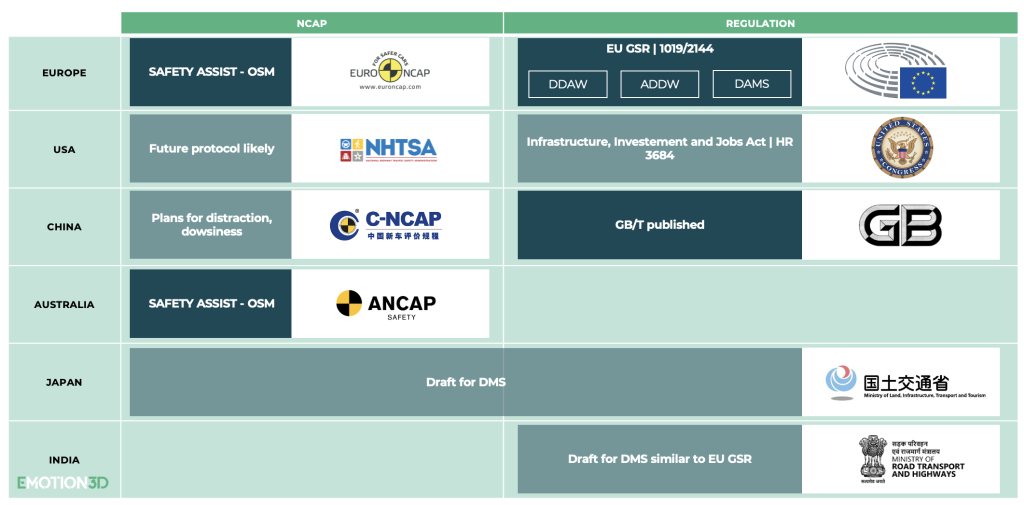Over the last few years, in-cabin analysis, and particularly driver monitoring systems (DMS), have become increasingly important in the automotive industry. What began as a small group of companies realizing the potential of DMS has now grown into a huge market. In this article, we will examine the current state of DMS in the automotive industry.
The Regulatory Push
Regulatory requirements have been a driving force in the development of DMS. In Europe, for instance, car manufacturers must install driver drowsiness and attention warning (DDAW) and advanced driver distraction warning (ADDW) systems in all new vehicles by 2024/2026 if they want to sell their cars. Additionally, the Euro NCAP will reward cars with direct sensing DMS solutions installed by 2023 – other NCAPs are already following Europe’s lead. Furthermore, as can be seen below, many other countries are preparing regulations around DMS. This has created a race among OEMs to ensure their vehicles are compliant and score well on NCAP tests to convince customers of their cars’ safety.

Technical Difficulties
Despite advancements in machine learning and deep learning solutions, DMS systems are not without their technical difficulties. The main issues faced today are the lack of contextual awareness and difficulties in assessing drowsiness.
Contextual awareness is critical for DMS to function intuitively and not become a distraction. Currently, systems do not have any contextual awareness, leading to potential false positives. Without knowing what is happening on the outside, it is difficult to determine what is catching a driver’s attention and to differentiate between distraction and aware driving.
Surely, an imperfect drowsiness detection is far better than no drowsiness detection. However, the industry needs to acknowledge that more work has to be done on this topic. Currently, the KSS (Karolinska Sleepiness Scale) is widely used to assess the performance of drowsiness algorithms. However, it is imperfect because it only assesses the subjective feeling of the study participant on a scale of 1 to 9. It does not take into account impairment, which is what we actually care about. Impairment and the feeling of drowsiness are not necessarily correlated, and the results are highly individual, making the scale a bad ground truth with plenty of room for improvement. Furthermore, the method of asking the study participant every few minutes about how they feel may warp results in an undesirable way.
Outlook
DMS is an essential safety feature that has become increasingly important in the automotive industry and will continue to do so. However, its current effectiveness is limited by the lack of contextual awareness and the flawed method used for assessing drowsiness detection. We as the automotive industry need to continue our work on improving the accuracy of DMS systems to ensure that they are reliable and not a distraction to drivers. At the same time, regulators need to be mindful of the limitations of DMS and work on developing appropriate testing protocols that consider the contextual aspects of driving.
In addition, other forms of impairment such as driving under the influence of drugs or alcohol will move more into the focus of regulators and companies such as emotion3D to develop solutions making our roads safer for everybody.
At emotion3D, we are creating improved ways to assess the driver’s internal state and we work with our partners on creating smart, contextually aware systems in which interior and exterior analysis play together and inform each other to create the safest experience for driver.

